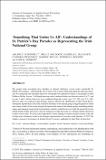Files in this item
"Something that unites us all” : understandings of St. Patrick’s Day parades as representing the Irish national group
Item metadata
| dc.contributor.author | O'Donnell, Aisling | |
| dc.contributor.author | Muldoon, Orla | |
| dc.contributor.author | Blaylock, Danielle | |
| dc.contributor.author | Stevenson, Clifford | |
| dc.contributor.author | Bryan, Dominic | |
| dc.contributor.author | Reicher, Stephen David | |
| dc.contributor.author | Pehrson, Samuel David | |
| dc.date.accessioned | 2015-05-06T16:01:02Z | |
| dc.date.available | 2015-05-06T16:01:02Z | |
| dc.date.issued | 2016-01-11 | |
| dc.identifier | 182354744 | |
| dc.identifier | bb09ab7e-7cda-4c8a-af8b-391539168c0c | |
| dc.identifier | 84954388676 | |
| dc.identifier | 000368016200005 | |
| dc.identifier.citation | O'Donnell , A , Muldoon , O , Blaylock , D , Stevenson , C , Bryan , D , Reicher , S D & Pehrson , S D 2016 , ' "Something that unites us all” : understandings of St. Patrick’s Day parades as representing the Irish national group ' , Journal of Community and Applied Social Psychology , vol. 26 , no. 1 , pp. 61-74 . https://doi.org/10.1002/casp.2236 | en |
| dc.identifier.issn | 1052-9284 | |
| dc.identifier.other | ORCID: /0000-0002-9259-6408/work/60196846 | |
| dc.identifier.uri | https://hdl.handle.net/10023/6624 | |
| dc.description.abstract | The present study investigates how attendees at national celebratory crowd events – specifically St. Patrick’s Day parades – understand the role of such events in representing and uniting the national community. We conducted semi-structured interviews with people who attended St. Patrick’s Day parades in either Dublin or Belfast. In year 1, full-length interviews were conducted before and after the events (N=17), and in years 1 and 2, shorter interviews were conducted during the events (year 1 N=170; year 2 N=142). Interview data were analysed using thematic analysis, allowing the identification of three broad themes. Participants reported that (a) the events extend the boundary of the national group, using participation to define who counts as Irish; (b) the events strategically represent the nature of the national group, maximising positive images and managing stereotypical representations (c) symbolism serves to unify the group but can also disrupt already fragile unity and so must be managed. Overall, this points to a strategic identity dimension to these crowd events. We discuss the implications of these findings for future research in terms of the role of large scale celebratory events in the strategic representation of everyday social identities. | |
| dc.format.extent | 14 | |
| dc.format.extent | 130491 | |
| dc.language.iso | eng | |
| dc.relation.ispartof | Journal of Community and Applied Social Psychology | en |
| dc.subject | National identity | en |
| dc.subject | Social identity | en |
| dc.subject | Parades | en |
| dc.subject | Rituals | en |
| dc.subject | Thematic analysis | en |
| dc.subject | Crown psychology | en |
| dc.subject | BF Psychology | en |
| dc.subject | NDAS | en |
| dc.subject.lcc | BF | en |
| dc.title | "Something that unites us all” : understandings of St. Patrick’s Day parades as representing the Irish national group | en |
| dc.type | Journal article | en |
| dc.contributor.sponsor | Economic & Social Research Council | en |
| dc.contributor.institution | University of St Andrews. School of Psychology and Neuroscience | en |
| dc.contributor.institution | University of St Andrews. St Andrews Sustainability Institute | en |
| dc.identifier.doi | https://doi.org/10.1002/casp.2236 | |
| dc.description.status | Peer reviewed | en |
| dc.identifier.grantnumber | RES-062-23-1140 | en |
This item appears in the following Collection(s)
Items in the St Andrews Research Repository are protected by copyright, with all rights reserved, unless otherwise indicated.

